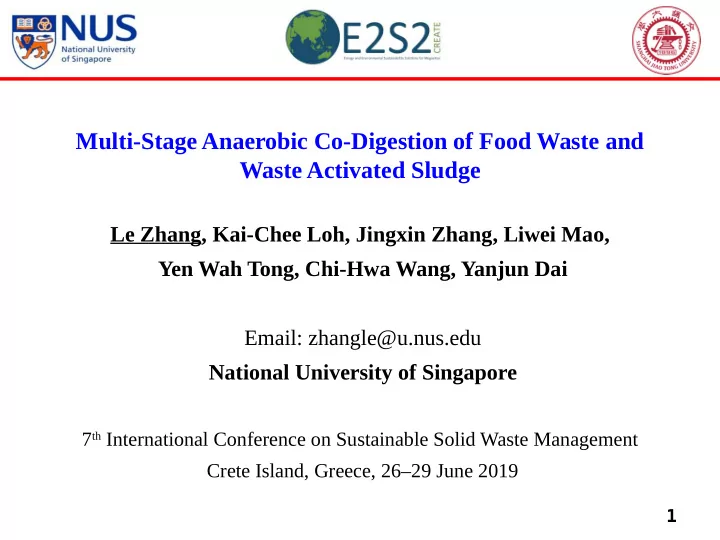

Multi-Stage Anaerobic Co-Digestion of Food Waste and Waste Activated Sludge Le Zhang, Kai-Chee Loh, Jingxin Zhang, Liwei Mao, Yen Wah Tong, Chi-Hwa Wang, Yanjun Dai Email: zhangle@u.nus.edu National University of Singapore 7 th International Conference on Sustainable Solid Waste Management Crete Island, Greece, 26–29 June 2019 1
Outline 1. Introduction 2. Research problem & analysis 3. Experimental design 4. Results and discussion 5. Conclusion and future work 2
Food waste issue 1. Introduction Sludge issue 2018 • Source: National Environment Agency (NEA) in Singapore • Food waste and Waste Activated Sludge: Biomass resources ! • Recycling rate is low • Potential environmental pollution Strategy: Anaerobic digestion technology, waste to energy 3
2. Research problem & analysis Anaerobic digestion (AD) technology Food waste Waste Activated Sludge Organic matters + Inoculum Single-stage AD reactor Hydrolysis and Acidogenesis (1) Volatile fatty acids Acetogenesis (2) Acetate and Hydrogen Methanogenesis (3) Two-stage AD reactor Biogas (Methane) Fuel: natural gas 4 Chemical feedstock Electricity generator
2. Research problem & analysis Anaerobic digestion (AD) technology Food waste Main problem: Waste Activated Sludge Given a digester chamber (one or two stage) Organic matters + Inoculum Only one or two pH allowed Hydrolysis and Acidogenesis (1) Volatile fatty acids Different optimal working pH Acetogenesis (2) Acetate and Hydrogen Three chambers simultaneously? Methanogenesis (3) Three different optimal working pH Biogas (Methane) Optimized AD process Fuel: natural gas 5 Chemical feedstock
2. Research problem & analysis Proposed approach: three-stage anaerobic co-digestion of food waste and waste activated sludge Hypothesis: ? 7
3. Experimental design Step 1. 1 L reactor tests-simulative multi-stage AD experiments pH; Conceptual design SCOD; Biogas composition Microbial community analysis validation Mechanism investigation Bench-scale demo Practical application Step 2. Bench-scale three-stage anaerobic co-digestion pH; Volatile solid removal Biogas composition Biogas volume 7
4. Results and discussion 4.1. Detailed characteristics of substrates and inoculum Table 1 . Detailed characteristics of substrates and seed sludge. Table 1 . Detailed characteristics of substrates and seed sludge. Characteristics Unit Seed sludge FW WAS Co-substrate TS wt% 1.71 0.01 28.29 0.51 14.93 0.20 21.19 0.28 VS wt% 1.22 0.01 27.15 0.49 11.29 0.11 18.84 0.20 VS/TS ratio - 0.71 0.96 0.76 0.89 pH - 7.61 0.1 5.21 0.1 8.60 0.2 6.51 0.1 33.56 0.04 49.70 0.41 32.25 0.02 43.12 0.42 Carbon % Hydrogen % 4.78 0.03 8.40 0.05 5.27 0.04 6.89 0.07 Nitrogen % 5.41 0.05 2.20 0.03 5.33 0.07 2.86 0.05 C/N ratio - 6.20 22.59 6.05 15.08 8 VS ratio = 1:2.5 (WAS/FW)
4. Results and discussion 4.2. Overall performance in simulative multi-stage AD experiments • 2.94 to 13.25 gVS/L • TSAco-D : highest average daily specific methane yield, 0.395 L/gVS, 19.3-49.1% higher than single and two stage reactors • pH and SCOD: explained changing tendency of methane yields 9
4. Results and discussion 4.3. Performance of bench-scale three-stage anaerobic co-digestion • Methane yields: 0.496 L/(gVS) • Maximum available OLR was between 6 and 7 g VS L -1 • A better bearing capacity for a high OLR than one- and two- stage digesters • Average VS reduction of TSAco-D (bench) reached 69% • 12-47% higher than that of one- and two-stage digesters • A higher VS removal efficiency in the three-stage AD process validated 10
4. Results and discussion 4.4. Analysis of microbial communities - Bacterial communities • Dominant species in three- stage digester according to the relative abundance were Proteobacteria (42.7 19.0%), Firmicutes (28.0 9.7%), Bacteroidetes (19.4 6.5%), Spirochaetes (2.2 1.2%), WS6 (1.7 1.1%), Synergistetes (2.3 0.9%), Chloroflexi (1.1 0.6%), Actinobacteria (0.9 0.5%), Euryarchaeota (0.4 0.5%), and Caldiserica (0.3 0.3%). 11
4. Results and discussion 4.4. Analysis of microbial communities - Bacterial communities • PCoA analysis revealed that the dominant microbes species composition in response to increase of digester stage number were distinctly different among one-, two-, and three-stage digesters. 12
4. Results and discussion 4.4. Analysis of microbial communities - Bacterial communities • CCA: the most predominant species of bacterial communities dynamically shifted along with the increasing stage number and OLR; • Above results indicated that community structures varied in response to these two process variables. 13
4. Results and discussion 4.5. Analysis of microbial communities - Archaeal communities • Methanogen genera : Methanosarcina (29.3 9.9%), Methanosaeta (22.1 7.1%), Methanobacterium (13.6 6.5%), Methanolinea (13.3 7.9%), Methanothermobacter (5.3 3.7%), Methanobrevibacter (5.0 2.3%), Methanomassiliicoccus (2.9 2.2), and Thermoplasmatales (1.7 1.9%) 14
4. Results and discussion 4.5. Analysis of microbial communities - Archaeal communities • Both digester stage and OLR were crucial environmental variables shaping the taxonomic patterns of the methanogens. 15
4. Results and discussion 4.5. Analysis of microbial communities - Archaeal communities • Included angle of the vector of the [stage] and the vector of [OLR] was larger than 90 , indicating that the effects of stage number had the negative correlation with OLR. • Dominant methanogenic pathway had a tendency of shifting from hydrogenotrophic pattern to acetoclastic pattern 16
5. Conclusion & Future work Conclusion 1. FW and waste activated sludge were co-digested in a three-stage anaerobic digester 2. Functional segregation favored selective enrichment of bacteria and methanogens 3 . Methanosarcina in a three-stage digester was 1.5-1.7 times higher than the controls 4. Average methane yield and VS removal increased by 13-52% and 12-47%, respectively 5. Feasibility of a bench-scale three-stage anaerobic digester scenario was validated Future work 1.Still need a longer running period in a continuous and recycled mode 2.For pH control in different stages, automatic regulating equipment may be introduced into the system 3.For potential industrial application of this new reactor, the economic feasibility analysis involving energy balance should be conducted 17
Acknowledgements • This research project was funded by the National Research Foundation, Prime Minister’s Office, Singapore under its Campus for Research Excellence and Technological Enterprise (CREATE) Programme. E2S2 Website: http://e2s2-create.org/index.html Address: 1 CREATE Way, CREATE Tower, #15-02 Singapore 138602 Thank you! 18
Recommend
More recommend